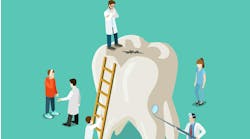by Rhonda R. Savage, DDS, and Ray Galvan, DDS
For more on this topic, go to www.dentaleconomics.com and search using the following key words: marketing, patient base, new patients, case acceptance, patient-centric.
With all things being equal — your location, training, fees, and team — what sets you apart from other dental practices? The answer is customer service. What do your customers (your patients) want?
They want the same things you do when you go shopping for something:
- Friendliness
- A reasonable wait time
- A good atmosphere
According to Fred Joyal, author of “Everything Is Marketing,” 81% of patients come to you by word-of-mouth referral.
On the downside, 85% of your patients will leave you for what they perceive is a lack of customer service. With Facebook, Twitter, and text messaging, patients can instantly say bad things about your practice. All it takes to earn a patient’s disapproval is a lack of common courtesy or inattention to details.
How can you improve the patient’s experience? Focus on developing trust — develop your staff, produce high-quality dentistry, and provide excellent customer service. Leave the external marketing to the experts!
Marketing needs to be an ongoing effort, not something that fluctuates depending upon your cash flow. Let’s examine the big five elements of patient-centric marketing.
Know what you want: plan and budget
How many patients do you need? If you’re a growing practice, you need a minimum of 25 to 40 new patients per doctor per month. If you’re an established practice, you still need 15 to 20 new patients per doctor per month to maintain your patient base.
▲ Develop a vision. Where do you want your practice to be in the next three, five, and 10 years? What kind of dentistry do you want to be doing? Let your team know your goals. You cannot do this alone
▲ Make a plan. Work with a reputable firm; you are not a marketing expert. Sesame Communication, Smile Design, Lighthouse … there are many more. For a list of 50 different marketing ideas, send me an e-mail at [email protected].
▲ Consider reach and frequency with external marketing. The best reach is marketing to those potential patients within a three- to five-mile radius surrounding your practice. As for frequency, depending upon your marketing company’s recommendation, you may need to send the same mailer out anywhere from six to 12 times before you realize a return on investment.
▲ Determine your return on investment. Any marketing piece that catches your eye will catch your patients’ eyes. People are attracted to things in threes and that focus on them, not you. Consider this phrase: Your needs! Your style! Your smile!
The focus needs to be on the patient. Look at the “I/you ratio” in the three sentences. Marketing should be patient-focused. You can measure the “I/you ratio” (how many words are about you vs. about the patient) by copying and pasting any marketing material and also your Web site into the Google site The We We Calculator.
▲ Set a budget. Spend two-thirds of your budget on internal marketing and one-third on external marketing. Why? Patients who have been referred by word-of-mouth come into your practice with a much higher level of trust and have an implicit expectation of your dental abilities. Case acceptance will be higher. From a budgetary standpoint, spend at least 4% of your collections on marketing if you need to grow your practice.
Retain well-trained, helpful, caring, and friendly employees
Your most important marketing tool is your staff! Patients like pleasant interactions with staff who genuinely care about performing their jobs well. Hire first for attitude, then personality and appearance.
With this in mind, let’s consider what it takes to retain a dedicated, happy, engaged team. In a survey of the more than 1,000 practices in which Miles and Associates has consulted, employees consistently rank the following four areas in order of importance when discussing what they value:
- Praise and appreciation
- Belonging to a close-knit team
- Responsibility and feeling like their voice matters in the practice
- Money and benefits
You can see that money and benefits aren’t everything to a team member. In fact, if you lose team members and they tell you they’re leaving for more money or a shorter commute, they’re being polite. Patients notice turnover and perceive a serious issue must exist in the practice.
Times are tough now when it comes to money and benefits. Linda Miles just wrote an article on DentistryIQ.com titled “Times Are Tough ... No Raises This Year.” If your practice has not increased, you cannot pay out the back door what isn’t coming in the front door.
Money, however, isn’t the most important thing to a dental team member. Focus on elevating the level of praise and appreciation at all levels of your practice. Many times team members say, “No matter how hard we work, no one seems to notice!”
Develop a closer-knit team by having effective, productive team meetings that are goal-oriented. Ask your team to help with the practice goals. Create a celebration list to accompany the completion of short, medium, and long-term goals. I like a good celebration!
Why celebrate at work? Because it improves camaraderie, recognizes the completion of a project, rewards the team, and most importantly, it’s fun!
Most dental offices don’t celebrate enough, and they definitely don’t celebrate during tough times. Ask for a volunteer to survey your team members. How would they like to celebrate? Celebrations can be creative and do not have to cost a lot of money. Think food, fun, and fellowship! Celebrate often!
Provide excellent customer service
- Connect with your patients. Spend time getting to know your patients before you put your hands in their mouths. Establish common ground and let them know something about yourself. Patients come to you assuming you know how to do the dentistry. What they really want is a relationship, and a relationship is a two-way street. Share a little about yourself every time patients come in so they feel they know you. Write down their interests in your charts and date the entries. You might even consider developing a social form or some other system of recording this information that is not within your progress notes. Personal notes should be dated.
- Stay connected. Follow up treatment with a phone call from the doctor. Yes, you can have a staff person do this for you, but it’s not nearly as powerful or meaningful. Hygienists should call within 24 hours of scaling/root planing and can make this call during office hours.
- Spend time educating patients. If you want to grow your practice, connect with your patients, and get patients to accept treatment by spending time with them, consider slowing down your hygiene time. Offices that routinely have patients on a 45- to 50-minute schedule have been shown to have less restorative and periodontal case acceptance, with a lower production in hygiene. Ninety percent of American adults have some form of periodontal disease. Are you taking the time your patients need to properly diagnose?
- Pay attention to detail. Dentistry is a detail-oriented profession. How detailed are your clinical records? Doctors, do you fill out your own records? I recommend you train your team to do this for you! The more your team writes and speaks for you, the better the communication will be in your practice, plus your production will increase! Doctors need to review and initial charts daily, route the chart back to the team member for correction, and then do a final review.
Are clinical records completed prior to dismissal of patient so your front-desk team can provide excellent customer service? Your financial coordinator needs to be able to process the insurance, collect the patient’s portion, and schedule the next appointment.
Well-defined financial policies are a form of customer service. Preparing patients in advance financially for their next appointment is crucial. A patient who is surprised financially will leave your practice.
Stay connected!
■ Recall and reactivate your patient! Recare or continuous care is one of the most important functions of your practice. Consider it a form of marketing. Make certain the person tackling this important job isn’t a “list checker.” The person calling needs to be warm, enthusiastic, and excited to make the calls. E-mail me for a copy of our recall and reactivation scripting. Keep in mind that with any scripting, patients do not like to be sold! The purpose of scripting is to take the message and internalize it, and then say it in your own words.
■ Connect through e-mail and the Internet. Connect with surveys and newsletters. There are many companies that can do this for you very cost-effectively.
Utilize your Web site as a value-added tool. Provide links with resources for your patients, such as perio.org, the American Cancer Association, the American Diabetic Association, the NIH for women’s health issues, and smoking cessation resources.
More suggestions: Have individual pictures of your team with their bios as well as pictures of your facility. Have a short video clip of the doctor(s) speaking, as well as another clip of a patient giving live testimonial. Have a button to click on called Rave Reviews. Scan in any thank you letters for the Rave Review spot.
■ Ask your patients how they’d like to confirm appointments. Ask patients on your HIPAA form: Would you like to be confirmed at home, at work, by cell phone, text messaging, or e-mail? Be certain you’re routinely gathering cell phone numbers and e-mail addresses; it’s the best way to stay connected in today’s world.
Ask your patients for referrals: invite, invite, invite!
Asking for referrals is uncomfortable to do. Consider this: When patients compliment the doctor or a team member, at that moment, they are giving you a piece of themselves.
When a team member is complimented on the doctor’s treatment, say: “Thank you so much! Many of our patients feel the same way about Dr. O’Neil. In fact, if you have friends or family who don’t have a great dentist like him, we’d love to have them come to our office!”
Or, if the doctor is complimented on a team member, say, “Thank you so much! Many of our patients have felt the same way about Carol! And, you know, if you have family or friends who don’t have a wonderful hygienist like Carol, we’d love to have them come to our practice!”
The patient will respond with “Oh! Do you need new patients?” to which you can say, “No, we don’t need new patients, but we love new patients who are just like you!”
You cannot be a thousand times better than another practice, but you can be better in a thousand small ways. The personal interaction, looking people in the eye, a calming demeanor, the confidence of a successful outcome, and concern evidenced by the team ... these are the reasons patients come to your practice. They come for “non-dental” things, all of which center around great customer service. Make a list of what you’re doing well, but always strive to be better, because good enough never is!
Rhonda Savage, DDS, has been in private practice for 16 years and is the CEO for Linda L. Miles and Associates, an internationally known practice-management and consulting business. A noted speaker, Dr. Savage lectures on practice management, esthetic dentistry, women’s health issues, periodontal disease, communication/marketing, and zoo dentistry. Contact her at [email protected].
Ray Galvan, DDS, is a practicing prosthodontist in Fair Lawn, N.J., who specializes in esthetic and prosthetic dentistry. A researcher and published author, he has been an affiliate professor of the New York University Dental School. He lectures nationally and internationally on prosthetic and esthetic topics. Contact him at [email protected].
A homework assignment and a goal for you and your team
On Monday, put a pad of paper and a telephone by every workstation.
For one week, perform a customer service survey of your practice.
Ask your team to be consultants in your own practice.
Draw a line down the middle of the page. Title the left side “What Was Done Well,” and title the right side “What We Could Do Better.”
Summarize your findings and use this as a topic for a team meeting.
Facilitate the change and then ... celebrate!





